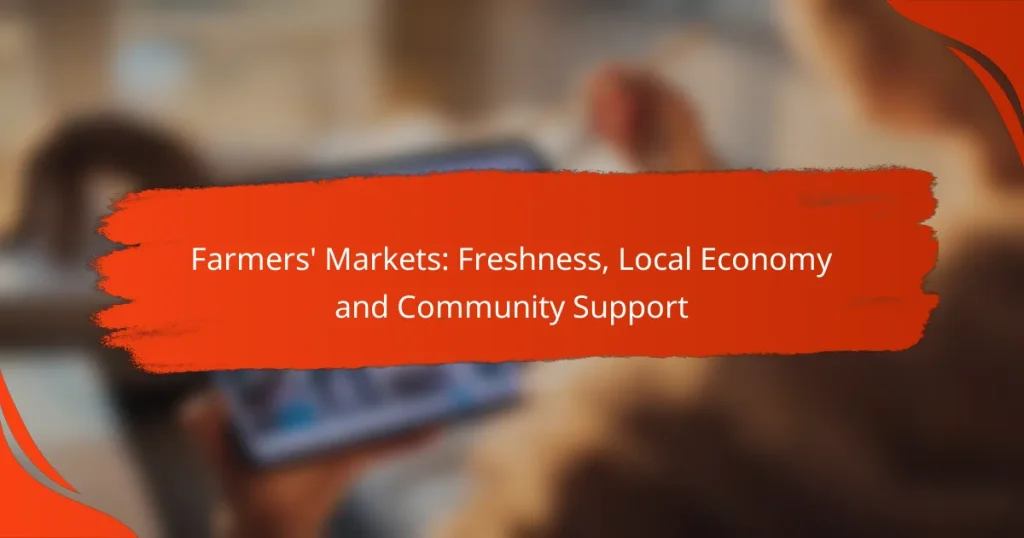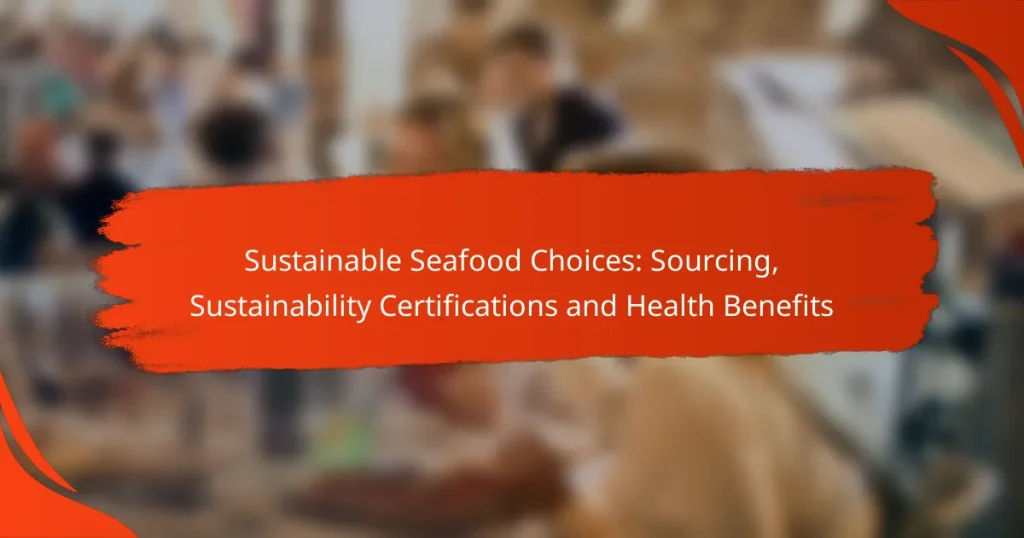Sustainable food practices are essential for promoting environmental health and supporting local economies. By focusing on methods such as organic farming and permaculture, consumers can enjoy food that is not only nutritious but also beneficial for the planet. Sourcing food locally through farmers’ markets and community programs further enhances these benefits, fostering a resilient food system. Embracing sustainable food choices leads to improved health outcomes and a stronger community connection.
Meal Prep Tips: Eco-Friendly Ingredients, Storage Solutions and Time Management
Plant-Based Recipes: Nutritional Value, Seasonal Ingredients and Cooking Methods
Organic Food Brands: Health Benefits, Environmental Impact and Ethical Sourcing
Farmers’ Markets: Freshness, Local Economy and Community Support
Sustainable Garden: Planning, Plant Selection and Maintenance
Sustainable Seafood Choices: Sourcing, Sustainability Certifications and Health Benefits
What are the best sustainable food practices in the UK?
The best sustainable food practices in the UK include organic farming, permaculture, and regenerative agriculture. These methods focus on environmental health, biodiversity, and soil quality while promoting local food systems.
Organic farming
Organic farming emphasizes the use of natural processes and materials to cultivate crops and raise livestock. This practice avoids synthetic fertilizers and pesticides, relying instead on crop rotation, composting, and biological pest control. In the UK, organic produce is often certified by organizations like the Soil Association, ensuring adherence to strict standards.
Farmers can benefit from organic farming by accessing premium markets, as consumers are increasingly willing to pay higher prices for organic products. However, yields may be lower compared to conventional farming, so careful planning and management are essential.
Permaculture
Permaculture is a design philosophy that seeks to create sustainable and self-sufficient agricultural systems by mimicking natural ecosystems. This approach integrates plants, animals, and people in a way that enhances biodiversity and reduces waste. In the UK, permaculture gardens often include a variety of plants that support each other, such as companion planting.
Implementing permaculture principles can lead to lower input costs and improved resilience against pests and diseases. However, it requires a deep understanding of local ecosystems and may involve a steep learning curve for new practitioners.
Regenerative agriculture
Regenerative agriculture focuses on restoring soil health and increasing biodiversity through practices like cover cropping, reduced tillage, and holistic grazing. This approach aims to sequester carbon in the soil, combat climate change, and enhance the overall resilience of farming systems. In the UK, regenerative practices are gaining traction among farmers looking to improve long-term productivity.
Farmers adopting regenerative agriculture often report improved soil quality and crop yields over time. However, transitioning from conventional methods may require significant changes in management practices and a willingness to experiment with new techniques.
How can I source sustainable food locally?
Sourcing sustainable food locally involves purchasing food that is grown or produced within your community, minimizing environmental impact and supporting local economies. Key avenues include farmers’ markets, Community Supported Agriculture (CSA) programs, and local food co-ops.
Farmers’ markets
Farmers’ markets are vibrant community spaces where local farmers sell their produce directly to consumers. Shopping at these markets allows you to meet the growers, learn about their farming practices, and often buy organic or pesticide-free products.
When visiting a farmers’ market, look for seasonal fruits and vegetables, as they are likely to be fresher and more flavorful. Be prepared to ask questions about how the food is grown and whether it meets sustainable practices.
Community Supported Agriculture (CSA)
Community Supported Agriculture (CSA) programs connect consumers directly with local farms. By purchasing a share of a farm’s harvest, you receive a regular supply of fresh produce throughout the growing season, typically delivered weekly.
Joining a CSA can provide access to a diverse range of seasonal foods while supporting local agriculture. Consider the commitment level and upfront costs, as shares may vary in price depending on the farm and the amount of produce offered.
Local food co-ops
Local food co-ops are member-owned grocery stores that prioritize sourcing from local and sustainable producers. They often offer a wide range of organic products, bulk items, and specialty foods that reflect community values.
Becoming a member of a food co-op can provide discounts and a say in the store’s operations. Look for co-ops that emphasize transparency in their sourcing practices and support for local farmers.
What are the benefits of sustainable food?
Sustainable food offers numerous advantages, including environmental protection, improved health outcomes, and support for local economies. By prioritizing sustainable practices, consumers can contribute to a healthier planet and community.
Environmental protection
Sustainable food production minimizes environmental impact by using methods that conserve resources and reduce pollution. Practices such as organic farming, crop rotation, and integrated pest management help maintain soil health and biodiversity.
Choosing local and seasonal foods also reduces carbon footprints associated with transportation. For instance, buying produce from nearby farms can cut greenhouse gas emissions significantly compared to imported goods.
Health benefits
Consuming sustainable food can lead to better health outcomes due to the absence of harmful chemicals and additives commonly found in conventional agriculture. Organic fruits and vegetables, for example, are often richer in nutrients and antioxidants.
Additionally, sustainable diets that emphasize whole foods, such as grains, legumes, and vegetables, can lower the risk of chronic diseases like obesity and heart disease. Incorporating a variety of these foods can enhance overall well-being.
Support for local economies
Buying sustainable food often means supporting local farmers and businesses, which strengthens community ties and boosts the local economy. When consumers purchase from farmers’ markets or local co-ops, they help keep money within their communities.
Moreover, investing in local food systems can create jobs and promote fair wages for workers. This not only benefits the economy but also fosters a sense of community and shared responsibility for sustainable practices.
How does sustainable food impact climate change?
Sustainable food practices significantly reduce greenhouse gas emissions, which are a major contributor to climate change. By focusing on eco-friendly farming methods, sustainable food systems can help mitigate the effects of global warming and promote environmental health.
Reduction of carbon footprint
Sustainable food production methods, such as organic farming and agroecology, typically result in a lower carbon footprint compared to conventional agriculture. These methods often use fewer synthetic fertilizers and pesticides, which are energy-intensive to produce, thereby reducing overall emissions.
Additionally, local sourcing of food minimizes transportation emissions. Choosing seasonal produce from nearby farms can cut down on the carbon footprint associated with long-distance food transport.
Soil health improvement
Practices like crop rotation, cover cropping, and reduced tillage enhance soil health, which is crucial for sustainable food systems. Healthy soil can sequester carbon, effectively removing it from the atmosphere and helping to combat climate change.
Implementing organic composting and avoiding harmful chemicals can improve soil biodiversity, leading to more resilient ecosystems. This resilience helps maintain productivity while reducing the need for synthetic inputs.
Water conservation
Sustainable food practices often prioritize water conservation through techniques such as drip irrigation and rainwater harvesting. These methods reduce water waste and ensure that crops receive adequate moisture without depleting local water resources.
Moreover, sustainable farming can improve watershed health, which benefits both agricultural and natural ecosystems. Farmers can adopt practices that enhance soil structure, allowing for better water retention and reducing runoff.
What certifications indicate sustainable food?
Certifications for sustainable food help consumers identify products that meet specific environmental and ethical standards. These certifications often focus on organic farming practices, fair labor conditions, and biodiversity conservation.
USDA Organic
The USDA Organic certification ensures that food products are produced without synthetic fertilizers, pesticides, and genetically modified organisms (GMOs). To qualify, farms must adhere to strict guidelines that promote ecological balance and biodiversity.
When shopping, look for the USDA Organic seal on products. This indicates that at least 95% of the ingredients are organic. It’s a reliable choice for consumers seeking to support sustainable agriculture.
Fair Trade Certified
Fair Trade Certified products guarantee that farmers receive fair wages and work under safe conditions. This certification aims to empower producers in developing countries by promoting equitable trade practices.
When purchasing Fair Trade products, you can expect higher quality and a commitment to sustainable farming practices. Look for the Fair Trade logo, which signifies that the product meets rigorous social, economic, and environmental standards.
Rainforest Alliance Certified
The Rainforest Alliance Certified label indicates that a product is sourced from farms that prioritize environmental conservation and the well-being of workers. This certification focuses on protecting biodiversity and ensuring sustainable land use.
Products with this certification often include coffee, tea, and chocolate. When you see the Rainforest Alliance seal, it means that the product supports sustainable farming practices that protect ecosystems and promote social responsibility.
What are the challenges of adopting sustainable food practices?
Adopting sustainable food practices presents several challenges, including higher costs, limited availability of local products, and the need for consumer education. These factors can hinder both producers and consumers from fully embracing sustainable options.
Cost Implications
The transition to sustainable food often involves higher initial costs for producers due to organic farming practices, certification fees, and investment in sustainable technologies. Consumers may face increased prices for sustainably sourced products, which can deter purchases, especially in areas with lower average incomes.
Availability of Sustainable Options
Access to sustainable food can be limited, particularly in urban areas where local farms are scarce. This can lead to reliance on imported goods, which may not meet sustainability standards. Farmers’ markets and community-supported agriculture (CSA) programs can help bridge this gap, but they may not be widely available.
Consumer Awareness and Education
Many consumers lack knowledge about the benefits of sustainable food practices and how to identify them. Educational initiatives are essential to inform the public about the environmental and health advantages of choosing sustainable options. Engaging community programs can foster awareness and encourage more sustainable consumer behavior.






